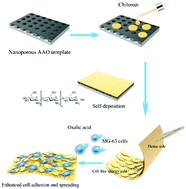Chitosan-based asymmetric topological membranes with cell-like features for healthcare applications†
Abstract
Chitosan-based guided tissue regeneration (GTR) membranes are extensively used in orthopedic/stomatological regenerative medicine since chitosan shares many chemical and structural similarities with glycosaminoglycans (GAGs) in the extracellular matrix. However, the available chitosan-based GTR membranes mostly lack topological features of natural tissues, resulting in unsatisfactory biocompatibility. To address this limitation, we developed a novel biologically-inspired asymmetric topological chitosan (ATCS) membrane supported by a nanoporous anodic aluminum oxide (AAO) template. We, thereafter, investigated the mechanical properties, degradation, and cytocompatibility of the ATCS membranes and compared them with those of the symmetric chitosan (SyCS) membranes, produced with a smooth Al template. The asymmetric topological structure significantly increased the tensile strength but decreased the extent of degradation of the ATCS membranes compared to those of SyCS. In the in vitro studies, the ATCS membranes outperformed the SyCS membranes in cytocompatibility due to their cell-like features. In addition to the ATCS membranes, the ethylene vinyl acetate (EVA) membranes with a similar cell-like structure were successfully fabricated using the AAO template to verify the universality of the AAO template-assisted technique. Accordingly, the AAO template-assisted strategy, defined in this study, is an innovative, universal, and facile way to fabricate polymeric asymmetric membranes with cell-like features. The bioengineered ATCS membranes with tunable degradability, prominent mechanical properties and biocompatibility are promising candidates for orthopedic healthcare applications.



 Please wait while we load your content...
Please wait while we load your content...